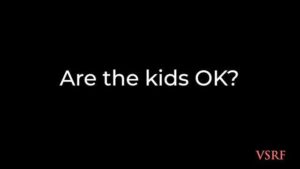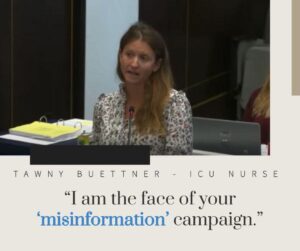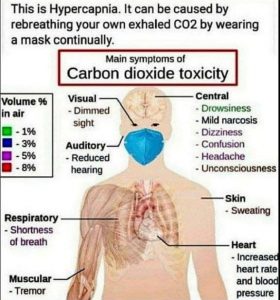Kids In Hospital “WITH” COVID (Narrative Deception)
Because all hospitals have implemented universal testing of inpatients for SARS-CoV-2, the “hospitalized with COVID-19” numbers are inflated world-wide.
CDC Says It ‘Accidentally‘ Inflated Children’s COVID Death Numbers In ‘Coding Logic Error’

It’s all COVID-positive patients, but I only have time to make a quick post today because I’m still working on the TGA/Atagi letter, so this post is for the Kids.
USA – Over-Counting COVID Kids
Rumble Clip | Twitter Clip | MSNBC Full Interview
Dec 30, 2021 MSNBC, Dr. Anthony Fauci – the White House chief medical adviser, explained that statistics showing a large jump in the number of children hospitalized “with Covid” does not reflect children being hospitalized: (01) (02)
“But the other important thing is that if you look at the children who are hospitalized, many of them are hospitalized with Covid as opposed to because of Covid, and what we mean by that
— if a child goes in the hospital, they automatically get tested for Covid.
— And they get counted as a Covid-hospitalized individual.
— When in fact, they may go in for a broken leg or appendicitis or something like that.
So, it’s over-counting the number of children who are, quote, ‘hospitalized with Covid,’ as opposed to because of Covid.”
CDC Corrects Inflated COVID KID Deaths
March 17, 2022: CDC Says It Accidentally Inflated Children’s COVID Death Numbers In ‘Coding Logic Error’
On Tuesday, the agency was reporting on its COVID Data Tracker that 1,755 Americans under age 18 had died from the virus since the pandemic began in spring 2020. Now, it is reporting 1,341 deaths in that category.
This week @CDCgov removed a total of 30,000 Covid deaths from the dashboard, reducing pediatric deaths by 24%. In small print at the bottom they cited a “coding error” as the reason for the incorrectly inflated numbers. pic.twitter.com/bme4eZ9UuG
— Nicole Saphier, MD (@NBSaphierMD) March 17, 2022
** Correction with updated numbers. The CDC may have removed closer to 70k deaths. Difficult to tell exacts as prior data has been removed. pic.twitter.com/zqoH1Wa1q4
— Nicole Saphier, MD (@NBSaphierMD) March 17, 2022
The CDC said the number was revised March 15 due to a “coding logic error,” according to a footnote on the agency’s COVID Data Tracker. Pediatric death counts were not the only ones to be lowered — total deaths were reduced by roughly 70,000.
“An adjustment was made to COVID Data Tracker’s mortality data on March 14 involving the removal of 72,277 — including 416 pediatric deaths — deaths previously reported across 26 states because CDC’s algorithm was accidentally counting deaths that were not COVID-19-related,” Jasmine Reed, a spokesperson for the CDC, told the Washington Examiner. “Working with near real-time data in an emergency is critical to guide decision-making, but may also mean we often have incomplete information when data are first reported.”
The CDC has encountered other issues with data reporting before. The agency was criticized in February after The New York Times reported that a large portion of the data being collected by the agency regarding COVID-19 was not being made available to the public. (03)
Earlier this year, Dr. Anthony Fauci admitted that hospitalization data for kids could also be misleading, as many of the children hospitalized with COVID-19 were there for reasons other than the virus.
Read the full article. MSN “March 17, 2022: CDC Says It Accidentally Inflated Children’s COVID Death Numbers In ‘Coding Logic Error’ (04)
2 USA Studies of Hospitalized Kids with COVID
Research Suggests Number of Kids Hospitalized for COVID Is Overcounted
Numbers are inflated as parents have begun vaccinating children under the expedited “emergency-use authorization” against a virus that, these findings suggest, poses a dramatically lower incidence of pediatric hospitalizations than the data have shown thus far:
1st Study – “For COVID” or “With COVID”
Lucile Packard Children’s Hospital “reported hospitalization rates likely lead to overestimation of the true disease burden”
45% SARS-CoV2-positive patients hospitalized “were unlikely to be caused by SARS-CoV-2.”
“39.3% of patients coded as SARS-CoV2 positive were asymptomatic.”
In other words, despite patients’ testing positive for the virus as part of the hospital’s universal screening, COVID-19 symptoms were absent, therefore it was not the reason for the hospitalization.
- Study “For COVID” or “With COVID”: Classification of SARS-CoV-2 Hospitalizations in Children – – August 2021 (05) (external link)
Conducted at a children’s hospital in Northern California, among the 117 pediatric SARS-CoV2-positive patients hospitalized between May 10, 2020, and February 10, 2021, the authors concluded that 53 of them (or 45 percent) “were unlikely to be caused by SARS-CoV-2.” The reasons for hospital admission for these “unlikely” patients included surgeries, cancer treatment, a psychiatric episode, urologic issues, and various infections such as cellulitis, among other diagnoses.
The study also found that 46 (or 39.3 percent) of patients coded as SARS-CoV2 positive were asymptomatic. In other words, despite patients’ testing positive for the virus as part of the hospital’s universal screening, COVID-19 symptoms were absent, therefore it was not the reason for the hospitalization. Any instance where the link between a positive SARS-CoV2 test and cause of admission was uncertain the authors erred toward giving a “likely” categorization.
2nd Study – “COVID-19 was not the primary reason for admission”
Fifth-largest Children’s Hospital in USA “During this time, our institution was the only facility caring for hospitalized pediatric patients who tested positive for SARS-CoV-2 within our large catchment area, and, thus, our population of these patients represents a comprehensive and accurate assessment of the disease burden of COVID-19 in children requiring hospitalization during the time period of interest.“
40% patients testing positive for SARS-CoV-2 had an “incidental” diagnosis, meaning there was no documentation of COVID-19 symptoms prior to hospitalization.
47%, as “potentially symptomatic,” which was defined as when “COVID-19 was not the primary reason for admission for these patients, and COVID-19 alone did not directly require hospitalization without the concomitant condition.
- Study (from fifth-largest children’s hospital in USA) Characteristics of Hospitalized Children Positive for SARS-CoV-2: Experience of a Large Center – August 2021 (06) (external link)
In the second study, at the fifth-largest children’s hospital in the country, out of 146 records listing patients as positive for SARS-CoV-2 from May 1, 2020, to September 30, 2020, the authors classified 58 (40 percent) as having “incidental” diagnosis, meaning there was no documentation of COVID-19 symptoms prior to hospitalization.
Like the first study, and as has been typical around the nation, this hospital implemented universal testing of inpatients for SARS-CoV-2. An example of incidentally SARS-CoV-2-positive patients are those who came to the hospital because of fractures. Patients who may have had COVID-19 symptoms but who had a clearly documented alternative reason for them, such as a child with abdominal pain and fever found to be related to an abdominal abscess, were also deemed to have incidental diagnosis.
The study categorized 68 patients, or 47 percent, as “potentially symptomatic,” which was defined as when “COVID-19 was not the primary reason for admission for these patients, and COVID-19 alone did not directly require hospitalization without the concomitant condition.” Examples of these patients were those with acute appendicitis, since that condition includes gastrointestinal symptoms that may also present in COVID-19.
“Scientific and media reports that inaccurately portray the risk of COVID-19 to children can do harm by alarming parents and providing justification for ongoing restrictions to in-person education and other programming. Via these studies, parents and policy-makers should be reassured that pediatric hospitalization for severe COVID-19 disease is indeed rare.”
“Taken together, these 2 studies underscore the importance of clearly distinguishing between children hospitalized with SARS-CoV-2 found on universal testing versus those hospitalized for COVID-19 disease.” (07)

The risk-benefit calculus of vaccinating children against a disease that poses a “very low likelihood of severe outcomes” to them, which, he argued, means it does not meet the definition of an “emergency.”
Stefan Baral, an infectious-diseases epidemiologist at Johns Hopkins
— Stefan Baral, an infectious-diseases epidemiologist and physician at Johns Hopkins (08) (09) (10)
Browse CovidKids:

Site Notifications/Chat:
- Telegram Post Updates @JourneyToABetterLife (channel)
- Telegram Chatroom @JourneyBetterLifeCHAT (say hi / share info)
- Gettr Post Updates @chesaus (like fakebook)
Videos:
References



















